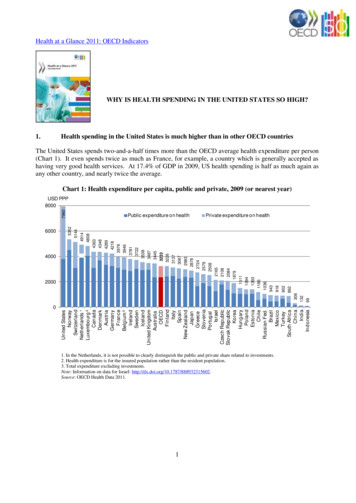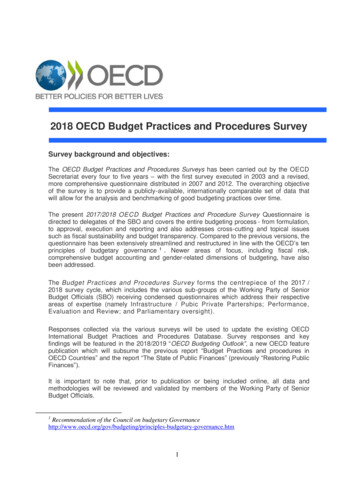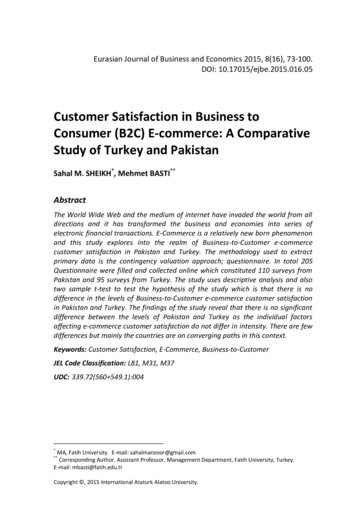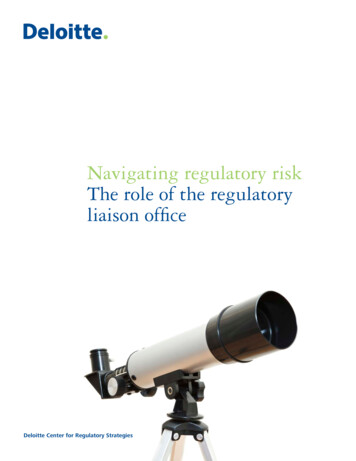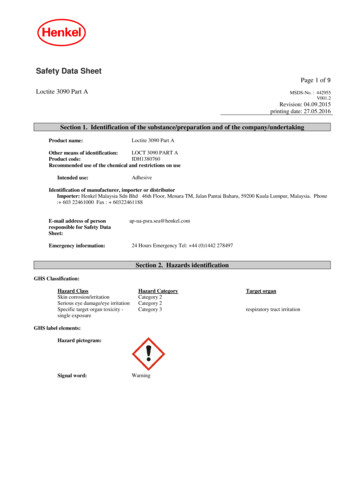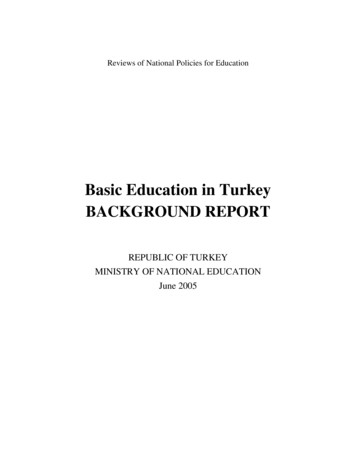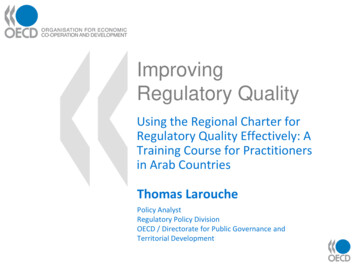
Transcription
ImprovingRegulatory QualityUsing the Regional Charter forRegulatory Quality Effectively: ATraining Course for Practitionersin Arab CountriesThomas LarouchePolicy AnalystRegulatory Policy DivisionOECD / Directorate for Public Governance andTerritorial Development
Presentation OutlineOutline of the presentation The regulatory system Why improve regulatory quality? Regulatory Impact analysis: a fundamental tool toimprove regulatory quality2
Improving Regulatory Quality: the Regulatory SystemRegulatory managementInstitutional arrangementsRegulatory PolicyMulti-level governanceStock of regulations Regulatory reform Burden reduction AdministrativesimplificationFlow of regulations Coordination Regulatory ImpactAnalysis (RIA)3
Improving Regulatory Quality: RationaleWhy improve regulatory quality? Economic, social and distributional benefits In a context of tight budgets, option less demandingthan fiscal policy Plays a central role in improving both citizen’s andinvestor confidence in a country Engaging in regulatory reform to improve regulatoryquality and establish permanent regulatoryoversight has proven a highly effective option in thepast4
Improving Regulatory Quality: RationaleCase study example: Korea 1997-98 crisis: GDP declined by 7.6% in Q1 1998, butrecovered to pre-crisis levels by the end of 1998. Crisiscaused by external shock, overleveraged and unprofitablecorporate sector and lack of supervision of financial sector At that time wide-ranging and ambitious program of reform,including the elimination of 50% of existing regulations Impact difficult to quantify but evidence of increased FDIlevel, reduction in compliance costs (4.4 % of GDP) andadministrative cost savings of 0.5 bn Korea successfully handled Asian financial crisis and currentcrisis is less severe than before5
Improving Regulatory Quality: RIARegulatory Impact Analysis (RIA) Section Outline:–––––ContextDesign and ProcessScopeImplementationElements6
RIA: ContextWhat is RIA? Systematic policy tool and decision process toexamine and measure the likely benefits, costs andeffects of new or existing regulation In the OECD, used most often to manage the flow ofregulation (US, Canada, UK, France, EU, etc.) Role in the development, review and reform ofregulations emphasized by the 1995, 1997 and 2005OECD guiding principles and recommendations forregulatory quality and performance7
RIA: ContextWhy is RIA important? Control the quality of regulation – a step inimproving competitiveness Evidence-based policy making Improves transparency – both within Governmentand Civil Society Simple language understandable for everyone andeasily accessible8
RIA: OECD ExperienceTrend in RIA adoption by central governments acrossOECD countries r of jurisdictions25
RIA: Design and Process10How does RIA work?The process of Regulatory Impact AnalysisDefinitionPolicy objectivesConsultationInvolving StakeholdersIdentificationRegulatory OptionsAssessmentCostsSelectionBest OptionDesignEnforcement, Compliance andmonitoring mechanismsBenefitsPolicy contextOther impactsAfter RIA is prepared: DECISION MAKING
RIA: Design and Process11How does RIA fit into the policymaking process?POLICY MAKING nAgreementPolicy Implementation
RIA: ScopePrimary or secondary legislation? Less and less divergence among OECD countries Primary legislation usually has more far reachingimpact Secondary regulation (decrees, bylaws) may settechnical standards, adoption usually not thattransparent It may be easier to constrain delegated regulatoryauthority12
RIA: ScopeApply to all proposals or only majorones? Many countries have linked RIA requirements to themagnitude of potential impacts of proposals Difficult to identify suitable threshold Quantitative vs. qualitative thresholds USA – annual costs exceeding 100 mil. Or more Canada: 10 million or more France: no threshold yet13
RIA: ImplementationInstitutional design Dynamic process between the center and sectoralministries regulators System of checks and balances Need for expertise in sectoral ministries/regulators,Division of tasks Balance between political discretion and need forexpertise, Timing The variation in RIA systems: presidential vsparliamentary regimes14
RIA: ImplementationCommon challenges Related to the tool: Problem identification, Consultation and data Considering alternatives, “Proportionate analysis” Quantification, Risk assessment Related to the structure/process Scope of application / selection of proposalsQuality control (oversight)Presentation / CommunicationIntegrate RIA up-stream (early in decision-making)Integrate RIA down-stream (“closing the loop”)Training, Multi-level context15
RIA: ImplementationOECD good practices (1) 1. Political commitment and endorsement at thehighest levels– Legal basis for RIA– Clear ministerial accountability 2. Allocate responsibilities for the RIA programme– Operational responsibilities with the services– Inter-service coordination– Central quality oversight16
RIA: ImplementationOECD good practices (2) 3. Target and prioritise RIA efforts– Scope of application / thresholds for when to do RIAs– Sectoral impacts 4. Develop comprehensive guidelines– Mandatory– Both on process and on technical aspects 5. Carry out sound analysis– Strategies for data collection– Consistent but flexible methodologies17
RIA: ImplementationOECD good practices (3) 6. Consultation / Transparency / Communication 7. Training, training, training 8. Apply RIA to both new and existing regulation18
RIA Elements19Elements of RIA: Overview1. Problemdefinition7. PostImplementationReview andEvaluation2. Selection ofalternatives6.Compliance /Enforcement3.Consultation5. Analysis ofCosts andBenefits4. InternationalRegulatoryCoordination
RIA Elements1. Problem definitionWhat is the problem? Is governmentaction justified? Many regulatory failures stem from an ill-defined ortoo narrow problem Countries have increasingly sought to justifygovernment intervention Problem / Objective setting is an essential step foreffective performance measurement20
RIA Elements2. AlternativesRequirements of the RIA process Clearly determine policy objectives– Case for regulation / Market failure / Policy goals Consideration of full range of available alternatives– Regulatory / Non regulatory Evaluate likely possibilities of success– Consider the role of government / characteristics of thesector– Discard unworkable proposals Cost benefit analysis of alternatives– Identify the alternative with the highest net benefit21
RIA Elements2. AlternativesAssessment of alternative policy instrumentsOECD countries, 200889Assesment of alternatives required butthe written form is not mandatoryWritten assesment required for onepolicy instrument14Written assesment required for morethan one policy instrumentNotes: Data presented for the 30 OECD member countries and the European Union.Source: OECD Regulatory Management Systems’ Indicators Survey 2008, www.oecd.org/regreform/indicators.
RIA Elements2. AlternativesAlternatives to what?Command and control regulation Prescriptive Black letter law May not promote good regulation Efficiency reducing Dynamic/ allocative/ technical Prevents innovation Can create market distortions/ barriers Potentially Ineffective Costly to business and the government May not ensure compliance A product of habit?23
RIA Elements2. Alternatives24What alternatives to consider? Regulatory alternatives Performance based regulation / Co-regulation / Economicinstruments - market incentives Non regulatory alternatives Voluntary codes / self regulation / information campaigns Spectrum of regulatory instruments:Market driven solutionsGovernment driven solutionsFree market MarketSelfInformation PerformanceCogovernedincentives regulation Education RegulationRegulationonly bycompetitionpolicyCommand-andcontrol
RIA Elements2. AlternativesPerformance based regulation Specifies outcomes or objectives and allows parties tochoose means of compliance Flexible, promotes innovation, lowers compliance costs May create uncertainty, favor large companies, difficultto monitor compliance, detailed guidance can becomede facto law Use when rate of technical change is high, incentives forcompliance are strong and a clear understanding of theproblem to be addressed25
RIA Elements2. AlternativesCo-regulation The regulatory role is shared between government andan industry or occupational body which can enforcebreaches of an industry code Utilises expertise of the industry or professionalassociation and promotes accountability Reduces requirements for government resources May raise barriers to entry and unintended monopolypower which may restrict competition Best used when industry is strongly homogenous,professional independence is important and selfenforcement is possible.26
RIA Elements2. AlternativesMarket incentives Economic incentives can be used to modify behavior, forexample through creating a market, taxing activitieswhich generate negative externalities, or subsidizingpositive activities Can be less costly than regulation, promote flexibility,innovation and be largely self enforcing Can be difficult to target and may generate unintendedmarket distortions, structurally difficult to remove whenno longer required Useful when behavioral change is required across thecommunity and sensitive to price signals27
RIA Elements2. AlternativesVoluntary codes / Self Regulation Industry self regulation uses voluntary codes to describethe types of activities that they agree to comply with toensure acceptable standards Voluntary codes have no legal authority: compliance isachieved through the participants desire to uphold thereputation of the industry Provides a market based solution to regulate ethicalbehavior – operationally practical Relies on sufficient market power to deter noncompliance Compliance may be low, can create barriers to entry28
RIA Elements2. AlternativesNegative Licensing Individuals and business that have demonstratedpast bad behavior are precluded from operating in aparticular industry Practical when governments seek to exclude personswith particular characteristics (eg criminals) ratherthan specify positive requirements Relatively low cost, does not require registration Exclusionary criteria may be difficult to specify andenforcement costs may be high29
RIA Elements2. AlternativesInformation campaigns An education program can be appropriate in caseswhere the market failure is an information problem.Depends on whether the target group can be identifiedand reached economically Can be very light handed May reduce costs of regulation and increase compliance May be conducted by government or business May not be successful in changing behavior Examples of advertising the effects of speeding, smokingor exercise30
RIA Elements2. AlternativesSome criteria for assessingalternatives For all options, how does it rate on Effectiveness– Promote compliance and meet objectives? Efficiency– Deliver a positive net benefit at lowest opportunitycost? Equity and Fairness– Transparent, inclusive, promote competition?31
RIA Elements2. AlternativesConclusion Case by case approach– Consideration of characteristics of industry sector Clearly linked to policy objectives.– Will it achieve its policy aims? Incentives and institutional issues.– Do the approaches ‘work with’ existing incentives?– Can they be effectively monitored and enforced? Evaluation of risks.– Likelihood and consequences of regulatory failure– Possibility for return to status quo Be creative– Adapt to human behaviour, new technology, new tricks,opportunity for policy learning32
RIA Elements3. ConsultationWhy consult? Valuable source of ideas and dataIntrinsic and instrumental valueIncreased transparency (increased trust)Draw upon collective intelligence of society: betteroutputs and outcomes at a lower cost People are more likely to accept and comply withpolicies they feel they have shaped
RIA Elements3. ConsultationConsultation is a central element ofRIA Form of quality assurance Means of ensuring data fully gathered and refiningmethodologies gives affected parties the opportunity to identify andcorrect faulty assumptions and reasoning Regulatory oversight bodies need to play a role inenhancing and refining consultation practices
RIA Elements4. International Regulatory CoordinationWhy coordinate? Collaborative identification of a regulatory agenda Increasing integration of international marketsmagnifies the salience of global systemic risks35
RIA Elements5. Costs and BenefitsBenefit-Cost Analysis (BCA) OECD recommends that the BCA should be usedwhere feasible in conducting RIA BCA, when applied appropriately in the regulatorycontext, attempts to take account of the full rangeof impacts, including environmental and socialimpacts, as well as economic impacts. Should serve as a basis for decision-making (choosethe option that maximises net benefits)36
RIA Elements5. Costs and Benefits: OECDRIA Requirements: Analysis of Costs, Benefits andPublic Accessibility in OECD countries (2005 and 2008)200520083530Number of OECD countries292526232021151023151615121250Publicly releaseRIAsIdentifyAlso quantifyBenefits of new regulationIdentifyAlso quantifyCosts of new regulationNote: This figure is based on country responses to the OECD Survey of regulatory management systems conducted in 2005 and 2008. Each column is thesum of country responses “always” and “for major regulations only”. Source: OECD Regulatory Management Systems’ Indicators Survey 1998, 2005 and2008, www.oecd.org/regreform/indicators.
RIA Elements6. Compliance and EnforcementCompliance and enforcement OECD 2005 principles: regulations should beefficiently applied with non-discriminatory andtransparent procedures for enforcing regulationsand with fair appeal processes Achieving a high level of compliance is a key factorin the effectiveness of regulations. How to influence the awareness, willingness andability of regulated groups to comply?
RIA Elements6. Compliance and Enforcement: OECDCompliance and enforcement issues, 2005 and 2008Regulatory policies explicitly require thatthe issue of securing compliance andenforcement are anticipated whendeveloping new regulationThere are specific policies on developingcompliance-friendly regulationWritten guidance on compliance and/orenforcement issues is available toregulatorsThere is a policy on risk based enforcement(*)200520080510152025Number of jurisdictionsNotes: Data for 2005 and 2008 are presented for the 30 OECD member countries and the European Union.(*) No data are available prior to 2008.Source: OECD Regulatory Management Systems’ Indicators Survey 2005 and 2008. www.oecd.org/regreform/indicators.30 31
RIA Elements7. Post-implementation ReviewPerformance measurement &evaluation Develop standardised evaluation techniques orcriteria Report on performance Review / Repeal regulation if necessary Automatic reviewing or repealing clauses may beconsidered, such as sunsetting40
RIA Elements7. Post-implementation ReviewRegulatory review and evaluation in OECD countries1998, 2005 and 2008Periodic evaluation of existing regulation mandatoryStandardised evaluation techniques or decisioncriteria to be used when regulation is reviewedReviews required to consider explicitly the consistencyof regulations in different areas and take steps toaddress areas of overlap/duplication/inconsistencyThere are mechanisms by which the public can makerecommendations to modify specific regulationsSunsetting is used for laws199820052008Specific primary laws include automatic reviewrequirements05101520Number of jurisdictionsNotes: Data for 1998 are not available for the European Union, Luxembourg, Poland and the Slovak Republic.This means that this figure is based on data for 27 countries in 1998 and for 30 countries and the EU in 2005/2008.(*) No data are available prior to 2005.Source: OECD Regulatory Management Systems’ Indicators Survey 1998, 2005 and 2008, www.oecd.org/regreform/indicators.2530 31
Reading ListFor more information: OECD country reviews on regulatory reform are available atwww.oecd.org/regreform OECD (2002), Regulatory Policies in OECD Countries: From Interventionism toRegulatory Governance OECD (2006), Alternatives to Traditional Regulation OECD (2008), Building an Institutional Framework for Regulatory ImpactAnalysis (RIA): Guidance for Policy Makers OECD (2009), Better Regulation in Europe: An Assessment of RegulatoryCapacity in 15 Member States of the European Union OECD (2009), Regulatory Impact Analysis: A Tool for Policy Coherence42
Thank you for yourattention!Thomas LarouchePolicy AnalystRegulatory Policy DivisionOECD / Directorate for Public Governance andTerritorial Developmentthomas.larouche@oecd.org
Regulatory Impact Analysis (RIA) 3 Improving Regulatory Quality: the Regulatory System Institutional arrangements Regulatory Policy Multi-level governance . . corporate sector and lack of supervision of financial sector At that time wide-ranging and ambitious program of reform,

